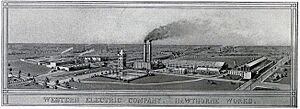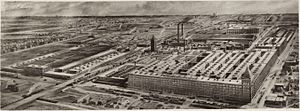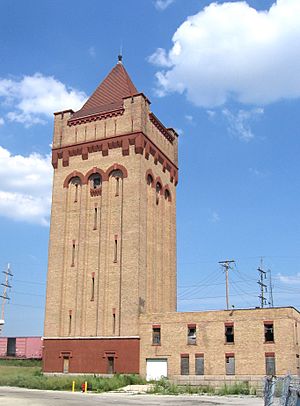Hawthorne Works facts for kids
The Hawthorne Works was a very large factory complex. It belonged to the Western Electric Company and was located in Cicero, Illinois. This huge factory not only had industrial buildings but also offered many helpful things for its workers, like places to relax or shop. It was named after the original name of Cicero, which was Hawthorne. The factory opened in 1905 and kept running until 1983. When it was busiest, the Hawthorne Works employed 45,000 people. They made a lot of telephone equipment, but also many other products that people used every day.
This factory is also famous for special studies done there in the 1920s. These studies looked at how people worked and managed others. The "Hawthorne effect" is a term named after this factory. It describes how people might change their behavior when they know they are being watched.
History of the Hawthorne Works
The Hawthorne Works factory was built where Cicero Avenue and Cermak Road meet. It first opened its doors in 1905. The factory got its name from Hawthorne, Illinois, which was a small town that later became part of Cicero. The complex had many buildings. It even had its own private railroad, called the Manufacturers' Junction Railway. This railway helped move products through the plant to a nearby train station. In its first few decades, the factory grew much larger.
The Hawthorne Works made a huge amount of telephone equipment. Besides telephones, Western Electric also produced many other things. These included different consumer products and electrical items, like refrigerators. At its busiest time, the factory had up to 45,000 employees. Workers often used bicycles to get around inside the very large plant.
The Hawthorne Works stayed open until 1983. It closed because of big changes happening with AT&T and the breakup of the Bell System. In the mid-1980s, a person named Donald L. Shoemaker bought the land. A shopping center was built where the factory once stood. One of the original towers from the factory still stands at the corner of 22nd Street and Cicero Avenue.
Because it was so important in American manufacturing, the Hawthorne Works was chosen for famous studies. These studies looked at how people worked in factories. The "Hawthorne effect" is named after this factory. Joseph Juran, a pioneer in Quality in North America, called the Hawthorne Works "the seed bed of the Quality Revolution." Other important quality experts, like Walter Shewhart and W. Edwards Deming, also worked or had connections to the Hawthorne Works.
On July 24, 1915, a sad event happened. The ship SS Eastland capsized in Chicago. Many of the 220 employees from Hawthorne Works who died were Czech immigrants. They were getting ready to leave on a company trip when the accident occurred.
What is the Hawthorne Effect?
The "Hawthorne effect" is a term that describes how people might change their behavior. This happens when they know they are being watched or observed. It was first noticed during studies at the Hawthorne Works. A psychologist named Elton Mayo collected the information. Later, another person, Henry A. Landsberger, looked at the information again and gave it the name "Hawthorne effect."
Hawthorne Works Museum
The Hawthorne Works Museum is run by Morton College. It tells the story of the Hawthorne Works factory. You can learn about the products it made and the people who worked there. The museum shows Western Electric products, like telephones, and other communication and electronics equipment. It also features inventions from Bell Laboratories. You can also learn about the local immigrant workers and the history of the area.




